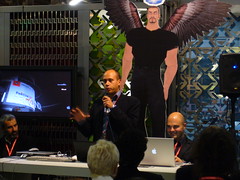Let me first of all say I’m really sorry to simply have dropped last Friday post, ahem, story but both me and Barbara were busy in the final phase of our new home (more on this soon); on aoperation that really took most of my spare time and that helped inspiring next Friday topic (stay tuned).
These few lines to say I’ll be at the presentation of “Community Management“, a cool book about enterprise 2.0, that will be held this evening at the SIAM 1838, Via Santa Marta18 in Milan starting at 6pm. See you there.
Live notes
FRANCO VILLANI (Commercial Director bTicino)
+400 sales men in Italy. They created the internal community because of their role in the market: they need innovation to preserve their leadership.
In their commercial area there’s a lot of old style sales style, but they try to differentiate from the rest of the arena: they have young engineers as salesmen who love their own job. They’re passionate about their business.
But as the company was growing both in its dimension and complexity the needed something to make simpler the communication between the centre and the sale network and vice-versa. They also needed an excuse to gain attention on this new opportunity.
The community was the answer.
In the meanwhile they bought two different companies that really brought a huge expansion in their sales network, and the tool was fundamental in the integration of the new colleagues.
6/7 months from idea to delivery. They’ve chosen a strongly mediated approach in order to have the people to exclusively speak about their business and avoid abuses of the software (such as complains about not having supa cool company cars ![]() .
.
GIUSEPPE SCARATTI (Università Cattolica)
Great potential: organizations need people that correctly interpret company philosphy and translate them in organizational methodologies that support company business. Practice bonds people, technologies and behaviours together.
Wenger says that people learn by entering as novices in practice communities.
EMANUELE QUINTARELLI (Web 2.0 expert)
Companies are already using knowledge management tools to aggregate peoples knowledge and help colleagues to have their work done. But technology seldom is successful (44% of people thinks that itranets really improve their works, IDC in 2006 found that 25% of our time looking for informations).
KM is the past.
Every company is a babel tower: multiple applications, silos, UIs; rigid central management and configurations; long change cycles by the IT department.
Enterprise 2.0 is the usage of social software platforms within companies, or between companies and their customers/partners.
Interaction between people stands visible and durable as time goes by. Enterpise 2.0 change our intranet in an ever-changing structure lead by users: enterprise level tagging, wikis, blogs, etc. (Microsoft Sharepoint)
Why adopting these 2.0 tools? Efficency gain (RSS feeds), competitive pressure that oblige you to continuously innovate.
Informal organization brings strong advantages: business efficency, reduced operational costs, improved customer satisfaction and company morale.
MARCO VERGEAT (FIAT CORPORATE UNIVERSITY CEO)
He cited Bravo and 500 FIAT cars cases where customers where strongly involved in the product projects (millions customers’ ideas to create the new 500 minicar).
Collaborative learning: learn by by the knowledge exchange between networks of people;
Informal learning: non intentional learning that represent the main quota of the learning on the job.
Self development: training the managerial skills of each one; huge quality levels of the participants is the assurance for a correct collaborative learning.
Too late. Really gotta go, hope to find the rest of the seminar backed-up online. And – s**t – cannot listen to Luca De Biase’s speech.

 I’m on a fast train connecting Florence to Milan together with my colleague Luciana (aka the uber wonderful
I’m on a fast train connecting Florence to Milan together with my colleague Luciana (aka the uber wonderful